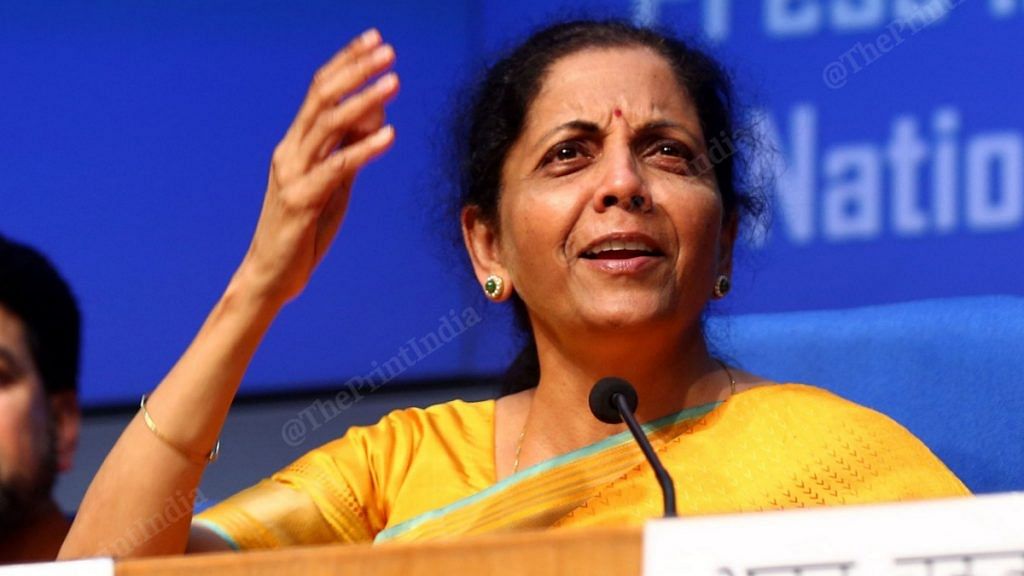The Narendra Modi government’s 2020 Budget made four important announcements that are seemingly unrelated — increase in deposit insurance to Rs 5 lakh from the earlier Rs 1 lakh; commitment to a tax charter that reduces harassment by tax officials; separation of the Trust for government employees from the Pension Fund Regulatory and Development Authority; and the listing of Life Insurance Corporation of India. What is common to these announcements is that they reflect the growing aspirations of an economy trying to break into the big league. But true reform in each of the sectors will only be possible through a fundamental restructuring of the underlying administration.
The Budget has picked on the right questions. But these are not problems that can be solved by tinkering at the edges.
Also read: Has Nirmala Sitharaman delivered on high Budget expectations or did slowdown leave no room?
Deposit insurance
Take the case of deposit insurance. The problem is as much the amount of insurance, as the delays in the payout. Analysis of data from 2013 to 2018 shows that on average it takes two years for the Deposit Insurance and Credit Guarantee Corporation (DICGC) to pay out claims. At the close of the last financial year, 25 bank failures were yet to be compensated with depositors waiting for more than six years on average. An increase in the amount does not change the practical reality that depositors are not able to access their funds for years.
If the Modi government wishes to reform deposit insurance, it needs an understanding of the frictions in the following processes: a) of recognising bad news in a bank as early as possible, b) of liquidation of a bank and c) of the actual payout. The answers to these lie in the FRDI bill that was proposed by the previous government. This would have led to the establishment of a Resolution Corporation, separate from the banking regulator and would be the deep structural reform for effective deposit insurance.
Also read: Focus on rural India, women, SC/STs — Budget 2020 fits into Modi govt’s welfare plank
New tax charter
The issue of harassment by tax officials has been on the government’s agenda for a while. India has already embarked on a faceless tax assessment system to avoid excessive discretion or harassment by tax officials. However, what is missing is a discussion of the problems in tax administration that lead officers to behave in a manner that is detrimental to tax-payers. We have to understand that officers are only responding to incentives, and change in behaviour calls for a fundamental change in incentives. For example, one cannot have a policy of setting tax targets on income tax officials, and at the same time, hope for good behaviour. This change will only come about through a fundamental reform in tax administration that has to begin with the separation of tax administration (Central Board of Direct Taxes) from tax policy (Ministry of Finance). Once that is done, there needs to be reform of the tax administration wherein a detailed procedural law governs the legislative, executive and quasi-judicial wings of the CBDT that brings about improved accountability.
Also read: Winners and Losers: Who got what in Nirmala Sitharaman’s Budget 2020
Separate trust for government employees
The Budget mentioned the need to separate the Trust for government employees from the PFRDA. There is indeed an uneasy tension between the role of PFRDA as a regulator and the role of PFRDA as an administrator of the National Pension System (NPS). However, it is not clear whether the separation of the Trust only for government employees is the right path forward. Once again, what is required is a coordinated effort that pulls various elements of the pensions story together such that we avoid fragmentation of an already fragmented market.
Also read: Nirmala Sitharaman cuts short her budget speech but it’s still India’s longest ever
LIC listing
Finally, the Initial Public Offering of the LIC is perhaps the boldest announcement in this Budget. This will only be possible if investors are able to see what is on LICs books. For example, the LIC would have to tell us the scrip-wise cost of investments over (at least) the last decade, and the current market value of these investments. A lot of this detail today remains unavailable. A move to the new accounting standards, IndAS, will mean that profit will have to be booked as the difference between fair market value (as opposed to the current book value) and actual sale. The Modi government will need to have the appetite to deal with skeletons that may emerge from the LICs closet and also be ready to lose the all-weather buyer for its own offer for sale and other transactions. This requires serious appetite for reform.
The Modi government now needs to get to the essence of the frictions in each of the sectors, and follow up with deep structural reform that will truly pave the way for the aspirations of a young India.
The author is an associate professor at the National Institute of Public Finance and Policy (NIPFP). Views are personal.
